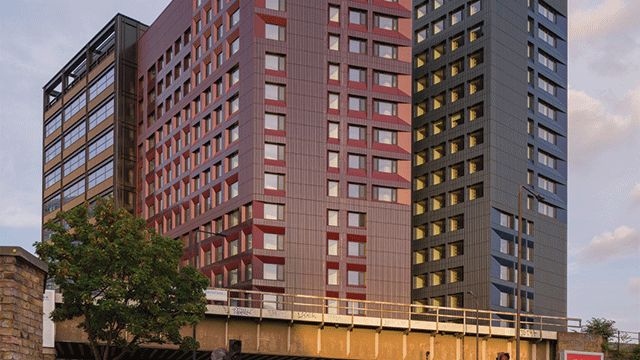London, Manchester and Edinburgh have the biggest growth potential for co-living accommodation in the UK, according to analysis from Cushman & Wakefield.
The analysis highlighted structural changes underpinning investment in the emerging residential subsector.
Cushman & Wakefield analysed demand metrics across the 18 UK cities with the highest number of private renters aged between 18 and 35, including the proportion earning over £40,000; PRS annual rental growth; student-to-bed ratio; postgraduate student numbers; and forecasts for population growth of young adults between now and 2040.
Co-living growth potential: top 10 cities
| Rank | UK city | Renters aged 18-35 earning £40k+ | Annual Rental Growth | Student to bed ratio | Postgraduate numbers | 20-34-year-old growth forecasts | Average rank |
| 1 | London | 35% | 14% | 2.5 | 118,105 | 7% | 2.0 |
| 2 | Manchester | 27% | 16% | 2.0 | 15,425 | 7% | 2.6 |
| 3 | Edinburgh | 36% | 17% | 2.7 | 17,305 | -3% | 2.8 |
| 4 | Bristol | 21% | 9% | 2.9 | 13,165 | 11% | 3.0 |
| =5 | Brighton | 27% | 8% | 2.4 | 5,045 | 8% | 3.2 |
| =5 | Cardiff | 24% | 10% | 2.3 | 10,955 | 7% | 3.2 |
| 7 | Glasgow | 15% | 15% | 2.4 | 26,305 | -6% | 3.4 |
| =8 | Birmingham | 15% | 11% | 2.0 | 15,420 | 8% | 3.6 |
| =8 | Leeds | 19% | 7% | 2.1 | 12,450 | 8% | 3.6 |
| 10 | Leicester | 10% | 8% | 1.7 | 8,985 | 11% | 3.8 |
Source: Cushman & Wakefield Index (Experian, Realyse, HESA/C&W Student Data, ONS)
London topped the rankings, outperforming for postgraduate student numbers, renters aged 18-35 earning over £40,000, and student-to-bed ratio.
The difficulty of buying a property in London has made it the leading co-living market to-date, with 2,300 completed co-living homes, 2,400 co-living homes under construction and 5,600 in planning.
The metrics vary greatly by borough, with the highest number of renters aged 18 to 35 earning more than £40,000 in Kensington and Chelsea (60%), Westminster (57%) and Tower Hamlets (55%), while the strongest population growth for young adults between now and 2040 was seen in Hammersmith and Fulham (12%), Wandsworth (11%) and Tower Hamlets (11%).
Manchester was second, outperforming for renters aged 18-35 earning over £40,000 (27%) and annual rental growth (16%). However, the student-to-bed ratio in Manchester sits at 2.0, below the national average, suggesting overspill from the student market for co-living may be lower than elsewhere.
Edinburgh was third, a leading city for renters aged 18-35 earning over £40,000 at 36%, annual rental growth at 17%, and a student-to-bed ratio of 2.7.
Both Edinburgh and Glasgow are robust student markets with high student-to-bed ratios and a substantial postgraduate audience. The cities have also experienced a significant rise in international students over the past two years, with an additional 12,550 in Glasgow and 7,085 in Edinburgh.
Millie Todd, head of UK living research and insight at Cushman & Wakefield, said: “Co-living is extending beyond London and gaining traction in various regions, and we expect that to continue. Outside London, Manchester’s co-living pipeline leads the way, while there are several notable complete schemes in the regions, including Zinc Works in Bristol, the Gorge in Exeter, Scape in Guildford and Voder Riverside in Leeds. As the cost of debt eases, the market adjusts to recent changes in building regulations, and planning regulations become clearer, we expect co-living investment to rise rapidly.
“Alongside the demand metrics we have focused on to predict future growth potential, it is important to consider land availability, planning, build feasibility and affordable housing agreements. These factors will have a major influence on where the co-living market will evolve.”
To send feedback, e-mail akanksha.soni@eg.co.uk or tweet @AkankshaEG











